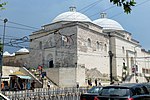Balaban Aga Mosque
1911 firesBuildings and structures demolished in 1930Byzantine architecture in IstanbulDemolished buildings and structures in IstanbulMosques in Istanbul

Balaban Aga Mosque (full name in Turkish: Balaban Ağa Mescidi, where mescit is the Turkish word for a small mosque) was a mosque in Istanbul, Turkey, converted from a former Byzantine building. Its usage during the Byzantine era is unclear. The small edifice - pulled down in 1930 to open a new road - was a minor example of architecture of the Byzantine early period in Constantinople.
Excerpt from the Wikipedia article Balaban Aga Mosque (License: CC BY-SA 3.0, Authors, Images).Balaban Aga Mosque
Zeynep Kamil Sokağı, Istanbul
Geographical coordinates (GPS) Address Nearby Places Show on map
Geographical coordinates (GPS)
| Latitude | Longitude |
|---|---|
| N 41.011 ° | E 28.9583 ° |
Address
Buzkan Tekstil
Zeynep Kamil Sokağı
34134 Istanbul
Türkiye
Open on Google Maps









